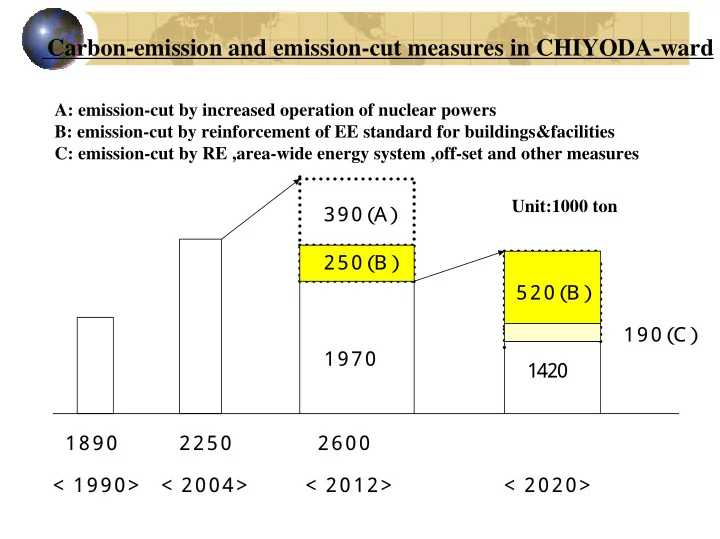

Carbon-emission and emission-cut measures in CHIYODA-ward A: emission-cut by increased operation of nuclear powers B: emission-cut by reinforcement of EE standard for buildings&facilities C: emission-cut by RE ,area-wide energy system ,off-set and other measures Unit:1000 ton 3 9 0 ( A ) 2 2 5 5 0 0 ( B ( B ) ) 5 2 0 ( B ) 5 2 0 ( B ) 1 9 0 ( C ) 1 9 7 0 1 4 2 0 1 8 9 0 2 2 5 0 2 6 0 0 <1 9 9 0 > <2 0 0 4 > <2 0 1 2 > <2 0 2 0 >
Area-wide low carbon policy & action program (1) <purpose> 1. Low carbon target can not be achieved by only single measure of EE for individual buildings. 2. Area-wide cooperative action is expected to work effectively in order to make the most of renewable energy source. < Scheme > 1. Following areas are designated as “Low carbon action area” under the ordinance of CHIYODA ward. * urban regeneration area designated by law * individual development project area * existing DHC service area * AEMS model area 2. Setting up “Area council” composed of area stakeholders, resource persons and CHIYODA ward.
Area-wide low carbon policy and action plan (2) 3. Sturdy and consultation * Sturdy on feasibility of the use of RE focusing on waste-heat and water-heat (river,sewerage,underground),biomass(waste,wood). *Sturdy on “off-set projects” if necessary. (domestic CDM is expected to be in practice) 4.Mapping out “Area-wide low carbon policy and action program” covering short, medium and long term. * Development plan of area-wide infrastructure for low carbon energy * Implementation plan of individual RE projects * Implementation plan of off-set projects * Time scheduling and cost-sharing plan 5.Sign for agreement, Setting in “planning documents”. *planning power could be effectively utilized 6.Setting up “Low carbon fund” contributed by members of area council *Fund money goes to the implementation of “action program”
Role of City Planning toward Low-carbon Society 1. It’s imperative to take more effective measures for the carbon reduction in the domestic sector and business & commercial sector. 2. As a first step, Reinforcement of Energy Efficiency (EE) for buildings and facilities. * Level-up of the standard of EE *Strengthening of building regulation (2000m2 300~500m2) 3. For meeting post-Kyoto target(medium/long term target), As a next step, “Area-wide carbon-cut measures” are indispensable. Area-wide measures could be smoo t 4. hly implemented by utilizing “opportunity&site”of City planning and urban development project.
Self-managed Corporate Action Program by business sector Regulative measures Measures to building&facilities (volume control) *EE building *EE facilities,electrical appliances Economic measures *Energy-management system (emission-trade, tax) <BEMS,HEMS> Self-managed Area Action Program(cooperative program in Action Area) *Improvement of EE for existing DHC systems <plant renewal, system-networking> *Deployment of DHC systems to new development areas. *Development of area-wide infrastructure for delivering Renewable Energy <waste-heat of incinerator, water-heat of sewerage,river,underground> *Self-planed Carbon-offset <Development of off-site RE> <Implementation of Low-carbon development in other areas> < Support of Low-carbon projects under “Domestic CDM scheme>
Making the most of planning tools & consensus-building procedures in planning process 1. Unified policy & action program of City planning with Climate Change 2. Grand design of future urban pattern & land use, urban regeneration,new urban development and transportation system incorporation of low-carbon program into planning documents 3. Area-wide planning and Area-wide urban development(or renewal) project. consensus- building to “Zero,Low-carbon development” 4. Multi-functioning of roads,parking-lots,parks&open spaces,sewerage as “Energy Infrastructure”
Pilot Project s in Large Cities 1. Formulation of “Low-carbon program” in “Urban Regeneration Area” designated by Urban Regeneration Promotion Law. 2. Implementation of Low-carbon projects in Regeneration Area. *Development of Thermal Grid by RE(waste heat, water heat) *Development of Thermal-network connecting existing DHCs *Development of Sustainable transportation system 3. Incorporation of “Thermal micro- grid” by biomass and solar- system * New development projects in suburban area *compact-town developments around railway stations * Housing-renewal project areas * Shopping-street areas
Pilot Project in Local Cities and Towns 1. Formulation and Implementation of “Low-carbon cluster development” toward “Energy-sustainable compact-city” 2. Energy system in low-carbon cluster development: *wood pellet boiler and solar thermal system *wood pellet (chip) fired cogeneration system 3. Cluster-development project sites: *Urban regeneration projects in the city center where have been facing population decrease and de-urbanization. *Surrounding area of public facilities where could function as “Cluster(community) energy center” *Mixed-use development based on block-reconfiguration *Supported by “Domestic CDM”(Investment from large-city as off-set)
What should be done First-step: * Formulation of model planning system <Master plan, Area plan, Infrastructure plan> *Development of “Zero-,Low-carbon Model Projects <new dev. project, renewal project> <100t saving-model, 500t model, 1000t model> *Study on Low-carbon energy business & investment <cost-effect, end-user’s merits> Second-step: *Formulation of PPS *Formulation of guidebook on action program for municipalities *Domestic CDM for the promotion of Low carbon projects Third-step: *Diffusion& Education <symposium, workshop, seminar> Forth-step: *Implementation of Low carbon planning in municipalities *Implementation of Zero-,Low-carbon projects in urban development
Recommend
More recommend